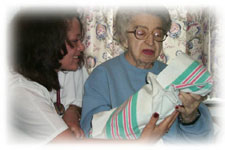Name:
|
|
Email:
|
|
|
1.
|
Which of these abbreviations indicates that a drug is to be administered at a regularly spaced intervals during each 24-hour period?
|
|
|
q12
|
|
|
qid
|
|
|
q6h, prn
|
|
2.
|
How many milligrams are equivalent to 0.045 grams?
|
|
|
4.5
|
|
|
45
|
|
|
450
|
|
3.
|
Which of these doses is the smallest?
|
|
|
0.1 gm
|
|
|
0.01 mg
|
|
|
10 mg
|
|
4.
|
A patient is to receive Cephalexin (Keflex) 1 gm po. Kelflex is available as 250 mg tablets. How many tablets should be administered?
|
|
|
1
|
|
|
2
|
|
|
4
|
|
5.
|
A patient is to receive Cyanocobalamin (Vitamin B-12) 30 mcg IM. Vitamin B-12 is available in 100 mcg per ml. How many milliliters should be administered?
|
|
|
0.1
|
|
|
0.3
|
|
|
3.0
|
|
6.
|
A patient is to receive Meperidine (Demerol) Hydrochloride 75 mg and Atropine Sulfate 0.3 mg IM preoperatively. Demerol is available in a prepackaged syringe Containing 100 mg per ml. Atropine is available in a vial containing 0.4 mg per ml. If the two drugs were combined in the same syringe for administration, how many Milliliters would be given?
|
|
|
1.05
|
|
|
1.5
|
|
|
2.0
|
|
7.
|
A U-100 Insulin syringe is illustrated below. The arrow indicates the level to which the syringe has been filled with Insulin injection (Regular Insulin) labeled 100U per ml. How many units of Insulin are in the syringe?
|
|
|
3.3
|
|
|
33
|
|
|
36
|
|
8.
|
Which of these is a major principle of pain management and should guide nursing action when administering prescribed analgesics to patients?
|
|
|
The patient in pain is the authority about the pain experience.
|
|
|
The patient with acute pain experiences more pain than one with chronic pain.
|
|
|
The patient with psychogenic pain does not experience real pain.
|
|
9.
|
Which of these ideas should be included in the instructions given to a patient who is taking an antihypertensive drug as Atenolol (Tenormin)?
|
|
|
If dizziness occurs as a side effect, schedule drug administration to allow for a half hour rest period after ingestion.
|
|
|
Should any dizziness occur, skip the next dose of the drug to determine if it is drug related.
|
|
|
Report any dizziness as a dosage change may be indicated
|
|
10.
|
A nurse is administering medications to residents in a long-term care facility where identification wrist-bands are not used. This is her first shift in this facility. The nurse does not know any of the residents. Which of these would most safely ensure they receive the correct medications?
|
|
|
Ask the residents their names prior to drug administration.
|
|
|
Call out the full name of each resident.
|
|
|
Have a staff member who knows the residents identify them by name.
|
|
11.
|
A patient's family member requests that the patient be given a prescribed narcotic analgesic. The nurse prepares the medication for administration but the patient refuses to take it. Which of these actions by the nurse would be appropriate?
|
|
|
Encourage the patient to reconsider taking the medication.
|
|
|
Label the medication and replace it for use at a later time.
|
|
|
Discard the medication in the presence of a witness and chart the action.
|
|
12.
|
When administering a medication to a patient via a nasogastric tube, the nurse should take which of these actions?
|
|
|
Depress the bulb syringe to facilitate the flow of the medication.
|
|
|
Avoid the addition of water into the syringe to prevent unnecessary dilution of the medication.
|
|
|
Hold the syringe high enough to allow the medication to flow in by gravity.
|
|
13.
|
When administering eye drops to a patient, the nurse should place the medication in the lower conjuctival sac to:
|
|
|
Reduce systemic absorption of the medication.
|
|
|
Increase circulation to the area.
|
|
|
Prevent injury to the cornea.
|
|
14.
|
A nurse is preparing to administer antibiotic drops in a patient's left ear. In which of these positions should the patient be placed?
|
|
|
High-Fowler's
|
|
|
Right side-lying
|
|
|
Prone
|
|
15.
|
A patient is to take Prednisone 10 mg po qid. The nurse should schedule this medication to be administered:
|
|
|
Before meals and at bedtime.
|
|
|
Every six hours.
|
|
|
After meals and at bedtime.
|
|
16.
|
When a patient is receiving Morphine Sulfate for pain control, the patient is likely to have:
|
|
|
A hyperactive cough reflex.
|
|
|
Decreased intestinal motility.
|
|
|
A widening pulse pressure.
|
|
17.
|
Antibiotic therapy should be carried out for the prescribed length if time for which of these reasons?
|
|
|
To prevent the occurrence of superinfections.
|
|
|
To encourage the development of antibodies.
|
|
|
To eradicate the targeted organism.
|
|
18.
|
A patient who is taking Gentamicin Sulfate (Garamycin) should be assessed for:
|
|
|
Acoustic nerve damage
|
|
|
Hypertension
|
|
|
Hypoglycemia
|
|
19.
|
Sulindac (Clinoril), which is used for long-term symptomatic treatment of arthritis, has a long half-life, which causes the drug to:
|
|
|
Produce fewer side effects.
|
|
|
Be more fully metabolized in the liver.
|
|
|
Have a prolonged duration of action.
|
|
20.
|
A patient who is taking an antihypertensive drug such as Clonidine Hydrochloride (Catapres) is likely to have which of these side effects?
|
|
|
Excessive tearing.
|
|
|
Constipation.
|
|
|
Increased sexual drive.
|
|
21.
|
Because of the action of the diuretic Hydrochlorothiazide (HydroDIURUL), a patient receiving this drug should be given which of these instructions?
|
|
|
"Include potassium-rich foods in the diet."
|
|
|
"Restrict sodium intake to a minimum."
|
|
|
"Avoid eating high-fiber foods."
|
|
22.
|
A patient is being treated for angina pectori with Nifedipine (Procardia). Which of these side effects is likely to occur?
|
|
|
Petechiae
|
|
|
Peripheral edema
|
|
|
Retinal detachment
|
|
23.
|
In which of these ways does Tolbutamide (Orinase) achieve its desired effect?
|
|
|
It promotes conversion of glucose to glycogen.
|
|
|
It stimulates pancreatic beta cells to release insulin.
|
|
|
It enhances the passage of glucose across cell membranes.
|
|
24.
|
Elderly patients are particularly prone to developing which of these adverse effects as a result of receiving Alprazolam (Xanax) ?
|
|
|
Urinary retention.
|
|
|
Disorientation
|
|
|
Muscular rigidity.
|
|
25.
|
A patient has received Flurazpam Hydrochloride (Dalmane) for sleep. Because of the effect of this drug, which of these nursing measures would be appropriate?
|
|
|
Observing the patient for signs widening pulse pressure.
|
|
|
Encouraging the patient to sleep in semi-Fowler's position.
|
|
|
Keeping a night light on in the patient's room.
|
|
26.
|
When anticonvulsive medications such as Phenytoin (Dilantin) sodium are stopped abruptly, the patient is at risk for the development of:
|
|
|
A severe hypoglycemic reaction.
|
|
|
A cerebral vascular occlusion.
|
|
|
Status epilepticus.
|
|
27.
|
A patient the Benzodiazepine drug Lorazapam (Ativan) 2 mg tid. Which of these instructions should be given to the patient?
|
|
|
Discontinue taking the medication if drowsiness is experienced.
|
|
|
Restrict the intake of coffee.
|
|
|
Take the medication on an empty stomach.
|
|
28.
|
While working in a facility, as you walk down a hallway, you hear a nursing assistant speaking sharply to an elderly resident during the resident's bath. You hear the resident exclaim "stop it, you're hurting me." You should:
|
|
|
Immediately go into the resident's room to investigate.
|
|
|
Report the nursing assistant to the floor and tell your agency.
|
|
|
Both a and b are correct.
|
|
29.
|
While working in a long-term care facility, you are assigned to an elderly patient who is receiving IV therapy. One of the nurses asks you to change the IV bag because she is too busy to do it. You should:
|
|
|
Tell the nurse that you do not feel comfortable doing this.
|
|
|
Tell the nurse you will do it after you have finished passing your medications.
|
|
|
Tell the nurse that this is beyond the scope of your expertise and that you will assist her in any other way you can.
|
|
30.
|
A patient has an order for Acetylsalicylic Acid (Aspirin) 0.6 gm po q 4h prn for temperature of 102 F (39c) or greater. The patient's temperature at 8 am is 102.4 (39.1 C) and the nurse administers aspirin. It is essential for the nurse to record the time of aspirin administration and the:
|
|
|
Patient's temperature at 9 AM.
|
|
|
Expected outcome of the medicine.
|
|
|
Patient's pulse and blood pressure.
|
|



